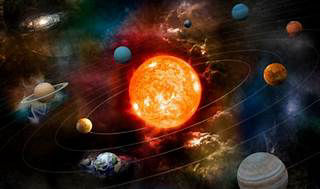
Solar System Story
The Cosmic Overture
Once upon a time, in the vast expanse of the cosmos, there existed a swirling cloud of stardust—a cosmic symphony waiting to be composed. This cloud, part of a larger nebula, held the promise of something extraordinary. Let us embark on a celestial journey and unravel the tale of our solar system.
Act I: The Stellar Prelude
Question 1: How did it all begin?
Answer: Approximately 4.6 billion years ago, a wispy cloud of stellar dust floated through space. This cloud was no ordinary mist; it was part of a grander ensemble—an interstellar nebula. Perhaps a nearby exploding star’s shockwave nudged it, causing the cloud to collapse inward.
Act II: The Birth of a Star
Question 2: What happened next?
Answer: As the cloud collapsed, it spun and swirled, forming a solar nebula—a cosmic disk of material. At its heart, a fiery furnace ignited—the Sun. Hydrogen atoms fused into helium, releasing an immense burst of energy. Our radiant star was born, illuminating the cosmic stage.
Act III: The Planetary Ballet
Question 3: How did planets come into play?
Answer: The Sun, voracious in its appetite, devoured over 99% of the nebular material. Yet, remnants lingered. Gravity orchestrated a cosmic dance—tiny bits clumped together. These celestial waltzes grew more intricate. Collisions birthed larger objects, and some achieved spherical grace. Thus, the planets emerged.
Rocky Planets: Closest to the Sun, these fiery spheres formed—Mercury, Venus, Earth, and Mars. Their solid surfaces endured the solar blaze.
Gas Giants: Farther out, where icy and gaseous material thrived, colossal giants twirled—Jupiter, Saturn, Uranus, and Neptune. Their majestic rings and swirling storms mesmerized the audience.
Act IV: The Cosmic Echo
Question 4: Are there echoes of the past?
Answer: Yes! The solar system’s overture left behind cosmic remnants. In the asteroid belt, fragments of the early days persist—failed attempts at planethood. And beyond, in the frigid reaches, comets glide. These icy wanderers remain largely unchanged since the system’s inception. Studying them unravels our cosmic saga.
Finale: A Celestial Symphony
And so, dear cosmic voyagers, our solar system’s symphony continues. Each planet, moon, and comet plays its unique note. The Sun conducts this grand orchestra, and we, mere stardust, listen in awe.
Questions and Answers:
Q: How long ago did the solar system form?
A: Approximately 4.6 billion years ago123.
Q: What triggered the collapse of the stellar cloud?
A: Possibly the shockwave from a nearby exploding star1.
Q: Why are rocky planets closer to the Sun?
A: Icy and gaseous material couldn’t survive the intense heat near the Sun, allowing rocky planets to form there1.
Q: What remains from the early days of the solar system?
A: Asteroids in the asteroid belt and comets in the outer reaches1.